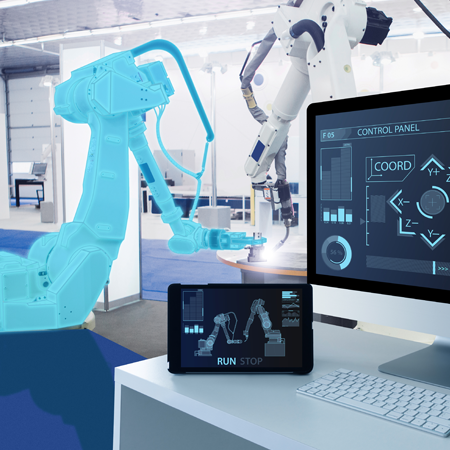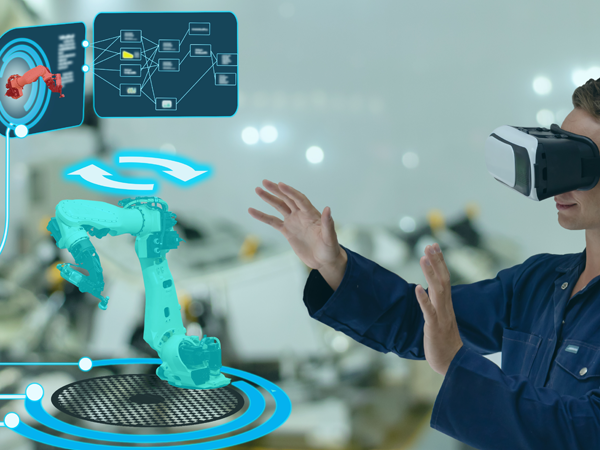The Road to Digital Manufacturing
The complexity of production processes is increasing exponentially due to customer demands, supply chain challenges and a hyper-competitive marketplace. Manufacturers must make high-quality, highly personalized products faster than ever before while managing costs and ensuring sustainability.
It’s simply not possible to use yesterday’s processes to develop tomorrow’s products. Manufacturers that not only manage but embrace complexity will have the competitive advantage.
Agility is the name of the game. The most successful manufacturers are using connected factories, robots and Industry 4.0 technologies. Electronics and embedded systems are being integrated into mechanical structures. Sensors and other Internet of Things (IoT) devices are collecting data and automating processes. Data is also streaming from design tools, machinery and countless other sources into sophisticated analytics software.
These manufacturers have transformed their operations with advanced technologies. They view technology as not only an enabler of manufacturing processes but the core component of an entirely new approach. They are leveraging digital twins to fully virtualize and automate the entire product lifecycle. Each step can be simulated and visualized for continuous optimization and refinement.
A key component of this transformation is the digital manufacturing model, in which various systems, processes and tools are integrated in an end-to-end approach. Through digital manufacturing, companies can begin to reap the benefits of transformation and respond more quickly to changing market conditions.

Digital Transformation
Digital transformation is the overarching concept that drives today’s technology-enabled business initiatives. It refers not only to technology adoption but to a fundamental rethinking of business processes and models. Technology and data empower individuals and organizations to adapt rapidly to change and deliver exceptional value to their customers.
The pace of digital transformation is accelerating as organizations face increasing pressure to become more agile, customer-centric and efficient. Organizations that embrace digital transformation are able to use technology to boost productivity, enhance quality and customer service, bring products to market faster, and drive innovation. Those that don’t are at risk of being displaced by more agile and responsive competitors.
The digital transformation journey looks different for every company, but each stage should realize benefits and gains. According to industry analysts, companies that pursue many parallel digital transformation initiatives see the biggest returns.
In the manufacturing realm, a study by Lifecycle Insights found that the most progressive companies had an average of 12 to 15 digital transformation initiatives. They saw tangible benefits:
- 10 percent of their projects hit or exceeded revenue.
- 9 percent of projects hit or exceeded margin goals.
- 20 percent fewer physical prototypes were required.
One-quarter of survey respondents had invested in product development process improvements the previous year, and another 38 percent planned to make investments the following year. Respondents said that these investments were essential to maintain a competitive edge.
Capabilities

The Digital Twin
The digital twin is a foundational component of transformation in manufacturing. Although the concept is relatively new, it has quickly become the focus of investments in manufacturing process improvement.
Digital twins are virtual representations of physical systems or objects, created through simulation, machine learning, virtual reality and other technologies and updated in real time. Manufacturers can visualize ideas and processes, choose the best methods and troubleshoot potential problems.
Digital twins enable manufacturers to create closed-loop connections between virtual and physical worlds across the entire value chain. Previously separate and sequential processes, from the shop floor to the top floor, are seamlessly integrated by advanced technologies. Benefits include:
- Enhanced cross-functional collaboration
- Fewer errors and delays and faster troubleshooting
- More-informed decision-making
Data generated by the factory in operation or the product in use is fed back into models that are continuously refined. Physics-based simulations combine with data analytics to provide actionable insights. Manufacturers can innovate faster and more reliably, while also requiring significantly fewer physical prototypes.

Digital Manufacturing
The digital twin is the driving concept behind digital manufacturing. In the digital manufacturing model, multiple computer-based solutions are combined in an integrated approach linking all areas of production. They are enhanced by 3-D visualization, simulation, analytics and collaboration tools to define product and manufacturing processes.
Designers and engineers work in close collaboration to visualize the entire process digitally. Greater collaboration across product and production lifecycle stages not only streamlines workflows but supports cross-domain capabilities, further blurring the boundaries between traditional stand-alone engineering domains.
Digital systems are linked to computer numerical control (CNC) systems to drive the various tools used to produce parts. Working together, these systems enable manufacturers to produce high-quality parts faster to address changing market conditions and meet customer demands.
The objective is to streamline the entire manufacturing process, from concept and design through tooling, machining and assembly. Done right, digital manufacturing can increase efficiency, reduce costs, minimize errors, improve decision-making and accelerate time to market.

Benefits of Digital Manufacturing
A primary benefit of digital manufacturing is enhancing operational efficiency. According to data from Deloitte, digital manufacturing increases productivity by 10 percent on average. Some manufacturers have seen productivity gains of more than 1,000 percent. Deloitte analysts believe that the adoption of digital technologies will help enable U.S. manufacturers to triple productivity through 2030.
With digital manufacturing, companies can fully capitalize on product lifecycle management (PLM). By integrating PLM and shop floor systems and better aligning design and manufacturing teams, digital manufacturing enables companies to scale rapidly, get products to market faster and save money by reducing costly downstream changes.
Digital manufacturing enables manufacturers to:
- Validate products in the digital world without physical prototypes
- Predict product and production performance
- Ensure that customer requirements have been met
Digital manufacturing reduces costs by minimizing errors and waste, improving performance and increasing factory utilization. Manufacturers can eliminate data silos so they can become more agile and make better decisions more quickly. They can also improve quality and enhance customer satisfaction.

Primary Components of Digital Manufacturing
Digital manufacturing incorporates simulation, analytics and other advanced technologies to create a highly automated, data-driven environment. It enables manufacturers to optimize three key areas of their operations.
Design. The design process has long been computerized, and advanced computer-aided solutions now enable 3-D modeling and visualization of everything from tooling and machining to production flows. Simulation enables designers and engineers to improve processes cheaply before production begins. Systems can then monitor production so that problems can be addressed and product designs quickly changed to optimize the manufacturing process.
Product lifecycle management. Digital manufacturing systems help to improve PLM through the collection and analysis of large amounts of data. It eliminates data silos by gathering information from disparate systems so that the data can be easily accessed, searched and analyzed. PLM enables manufacturers to manage processes from the conception and design of a product through its fabrication and service. It also improves decision-making and continuous performance improvements.
Smart factory. The term “smart factory” refers to the use of computer-aided tools and equipment and advanced technologies that are fully integrated in an end-to-end digitized process. It also incorporates sensors and other Industrial Internet of Things (IIoT) devices to gather data and provide real-time feedback. By unifying information technology (IT) and operations technology (OT), manufacturers gain greater visibility and control over processes and the ability to make better decisions and respond more rapidly to issues.
Specific Use Cases
Digital manufacturing is also driving innovative solutions that are helping to further transform the manufacturing environment. Although new techniques are constantly emerging, three technologies are seeing widespread adoption across a broad range of industries.
Rapid prototyping. Computer-aided systems enable manufacturers to quickly develop and fabricate a scale model of a part or assembly without the need for patterns, molds and tooling. Designs are created using 3-D software tools and fabricated using additive manufacturing techniques. Rapid prototyping enables companies to improve product designs and get products to market faster while reducing costs.
Additive manufacturing. Also known as 3-D printing, additive manufacturing enables the fabrication of parts by adding layer upon layer of material rather than removing material from a solid workpiece. CAD software or 3-D object scanners are used to direct the 3-D printer. Additive manufacturing reduces costs and waste and enables the development of stronger, lighter parts.
Augmented reality. Computer-generate input creates a virtual manufacturing experience that responds to the user’s environment. Engineers can visualize real objects along with CAD drawings and other data using desktop computers, mobile devices, headsets and smart glasses. Operators on the factory floor can gain a real-time view of processes, problems and maintenance concerns.

How Saratech Helps Enable Digital Manufacturing
As with any digital transformation initiative, the journey to digital manufacturing can be long and difficult. Entrenched processes and mindsets are slow to change, and manufacturers may be reluctant to abandon tried-and-true technologies. A trusted partner can help to facilitate the transition, assist with technology selection and integration, and reduce risk.
Saratech’s consultants and engineers have decades of experience in manufacturing. We also have longstanding partnerships with industry leaders who have developed innovative solutions that bring the digital twin to life. Together, we help manufacturers unlock the power of the digital manufacturing model.
Saratech has established a Manufacturing Center of Excellence to help customers develop and execute their digital manufacturing strategies. Through the Center of Excellence, we are able to showcase leading-edge technologies. Additionally, our experts deliver a comprehensive suite of services across the manufacturing lifecycle that serve as building blocks for the digital manufacturing model.
Software implementation, customization and training. We assist in the selection, licensing and installation of industry-leading manufacturing software. This includes customization and tailoring of add-ons to meet specific customer requirements, including the creation of macros and other applications that increase efficiency. Our team also provides customized training to fill skills gaps and accelerate the time-to-value of these solutions.
Engineering and rapid prototyping. In some cases, customers have engineering work packages that they need to offload. Saratech can provide the engineering expertise and technologies to complete design projects of any size across a wide range of industries. We can also design and build prototypes based upon predefined technical requirements using 3-D printing and materials such as hard and soft metals.
CNC programming services. Saratech’s high-end CNC programming services provide needed expertise and fill resource shortages to help keep production schedules on track. Our programmers have experience with a wide range of CNC systems and environments, and work in close collaboration with the customer to ensure that the delivered program meets all specifications and requirements. We also help customers solve technical challenges with methodologies and tool design.
Postprocessor development. The G-code used to program CNC machines is a universal language that’s not specific to a particular machine. Postprocessors convert the toolpaths created in CAM software into G-code for a specific machine. Saratech’s postprocessor development services provide customers with the confidence that the process will be successful and a part won’t be inadvertently damaged. We also maintain and update postprocessors as customers add new tools, processes and capabilities in their shop.
Simulation. Saratech helps customers take advantage of industry-leading simulation tools to reduce costs and development time. We can also edit and tailor software simulation “kits” for our customers’ environments. This allows customers to simulate the defined tool path in real time using the actual constraints of their particular machine. They can identify potential problems and optimize the solution by editing the CNC program before running the process.

